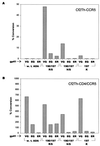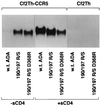Adaptation of a CCR5-using, primary human immunodeficiency virus type 1 isolate for CD4-independent replication
- PMID: 10482561
- PMCID: PMC112828
- DOI: 10.1128/JVI.73.10.8120-8126.1999
Adaptation of a CCR5-using, primary human immunodeficiency virus type 1 isolate for CD4-independent replication
Abstract
The gp120 envelope glycoprotein of the human immunodeficiency virus type 1 (HIV-1) promotes virus entry by sequentially binding CD4 and chemokine receptors on the target cell. Primary, clinical HIV-1 isolates require interaction with CD4 to allow gp120 to bind the CCR5 chemokine receptor efficiently. We adapted a primary HIV-1 isolate, ADA, to replicate in CD4-negative canine cells expressing human CCR5. The gp120 changes responsible for the adaptation were limited to alteration of glycosylation addition sites in the V2 loop-V1-V2 stem. The gp120 glycoproteins of the adapted viruses bound CCR5 directly, without prior interaction with CD4. Thus, a major function of CD4 binding in the entry of primary HIV-1 isolates can be bypassed by changes in the gp120 V1-V2 elements, which allow the envelope glycoproteins to assume a conformation competent for CCR5 binding.
Figures




Similar articles
-
Loss of a single N-linked glycan allows CD4-independent human immunodeficiency virus type 1 infection by altering the position of the gp120 V1/V2 variable loops.J Virol. 2001 Apr;75(7):3435-43. doi: 10.1128/JVI.75.7.3435-3443.2001. J Virol. 2001. PMID: 11238869 Free PMC article.
-
Differential CD4/CCR5 utilization, gp120 conformation, and neutralization sensitivity between envelopes from a microglia-adapted human immunodeficiency virus type 1 and its parental isolate.J Virol. 2001 Apr;75(8):3568-80. doi: 10.1128/JVI.75.8.3568-3580.2001. J Virol. 2001. PMID: 11264346 Free PMC article.
-
V2 loop glycosylation of the human immunodeficiency virus type 1 SF162 envelope facilitates interaction of this protein with CD4 and CCR5 receptors and protects the virus from neutralization by anti-V3 loop and anti-CD4 binding site antibodies.J Virol. 2000 Aug;74(15):6769-76. doi: 10.1128/jvi.74.15.6769-6776.2000. J Virol. 2000. PMID: 10888615 Free PMC article.
-
Structural interactions between chemokine receptors, gp120 Env and CD4.Semin Immunol. 1998 Jun;10(3):249-57. doi: 10.1006/smim.1998.0127. Semin Immunol. 1998. PMID: 9653051 Review.
-
Macrophage activation through CCR5- and CXCR4-mediated gp120-elicited signaling pathways.J Leukoc Biol. 2003 Nov;74(5):676-82. doi: 10.1189/jlb.0503206. Epub 2003 Jul 22. J Leukoc Biol. 2003. PMID: 12960231 Review.
Cited by
-
Design, synthesis and evaluation of small molecule CD4-mimics as entry inhibitors possessing broad spectrum anti-HIV-1 activity.Bioorg Med Chem. 2016 Nov 15;24(22):5988-6003. doi: 10.1016/j.bmc.2016.09.057. Epub 2016 Sep 24. Bioorg Med Chem. 2016. PMID: 27707628 Free PMC article.
-
Methamphetamine enhances cell-associated feline immunodeficiency virus replication in astrocytes.J Neurovirol. 2002 Jun;8(3):240-9. doi: 10.1080/13550280290049660. J Neurovirol. 2002. PMID: 12053278
-
CD4 binding site antibodies inhibit human immunodeficiency virus gp120 envelope glycoprotein interaction with CCR5.J Virol. 2003 Jan;77(1):713-8. doi: 10.1128/jvi.77.1.713-718.2003. J Virol. 2003. PMID: 12477875 Free PMC article.
-
Binding of recombinant feline immunodeficiency virus surface glycoprotein to feline cells: role of CXCR4, cell-surface heparans, and an unidentified non-CXCR4 receptor.J Virol. 2001 May;75(10):4528-39. doi: 10.1128/JVI.75.10.4528-4539.2001. J Virol. 2001. PMID: 11312323 Free PMC article.
-
CD4-independent infection of two CD4(-)/CCR5(-)/CXCR4(+) pre-T-cell lines by human and simian immunodeficiency viruses.J Virol. 2000 Jul;74(14):6689-94. doi: 10.1128/jvi.74.14.6689-6694.2000. J Virol. 2000. PMID: 10864687 Free PMC article.
References
-
- Alkhatib G, Combadiere C, Broder C C, Feng Y, Kennedy P E, Murphy P M, Berger E A. CC-CKR5: a RANTES, MIP-1a, MIP-1b receptor as a fusion cofactor for macrophage-tropic HIV-1. Science. 1996;272:1955–1958. - PubMed
-
- Allan J, Lee T H, McLane M F, Sodroski J, Haseltine W, Essex M. Identification of the major envelope glycoprotein product of HTLV-III. Science. 1983;228:1322–1323.
-
- Allan J S. Receptor-mediated activation of immunodeficiency viruses in viral fusion. Science. 1991;252:1322–1323. - PubMed
-
- Allan J S, Strauss J, Buck D W. Enhancement of SIV infection with soluble receptor molecules. Science. 1990;247:1084–1088. - PubMed
-
- Barre-Sinoussi F, Chermann J C, Rey F, Nugeyre M T, Chamaret S, Gruest J, Dauget C, Axler-Bin C, Vezinet-Brun F, Rouzioux C, Rozenbaum W, Montagnier L. Isolation of a T-lymphocyte retrovirus from a patient at risk for acquired immunodeficiency syndrome (AIDS) Science. 1983;220:868–871. - PubMed
Publication types
MeSH terms
Substances
Grants and funding
LinkOut - more resources
Full Text Sources
Other Literature Sources
Research Materials

